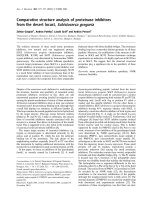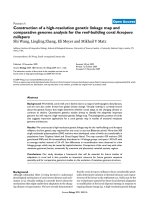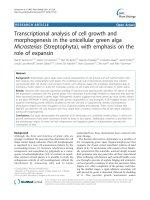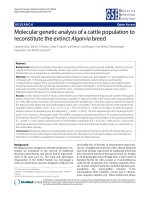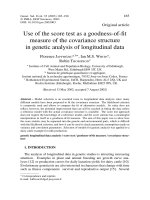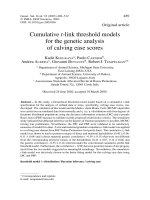Comparative genetic analysis of the transcriptional regulatory DNA of the oxytocin and vasopressin genes
Bạn đang xem bản rút gọn của tài liệu. Xem và tải ngay bản đầy đủ của tài liệu tại đây (3.91 MB, 176 trang )
COMPARATIVE GENETIC ANALYSIS OF THE
TRANSCRIPTIONAL REGULATORY DNA OF
THE OXYTOCIN
AND VASOPRESSIN GENES
Patrick Gilligan
(M.Sc. University of Waikato)
A THESIS SUBMITTED FOR THE
DEGREE OF DOCTOR OF PHILOSOPHY
INSTITUTE OF MOLECULAR AND CELL BIOLOGY
NATIONAL UNIVERSITY OF SINGAPORE
2004
ii
Nothing in biology makes sense except in the light of evolution.
Theodosius Dobzhansky
The American Biology Teacher, 35:125-129
iii
Acknowledgements
I thank:
Firstly, my supervisor Byrappa Venkatesh.
Past and present members of the Marine Molecular Genomics lab, including Tay Boon
Hui (who helped with cloning and other stuff), Michael Richardson, Choong Po Loong,
Meng Hwee, Diane Tan, Goh Boon Young, Eugene Kroll, Hawys, Alan Christoffels,
Esther Koh, variously for help and making the lab a good place to work.
Roland Degenkolbe, for copious discussions, biochemical advice, style editing and
general generously provided opinions.
Sathivel Poniah for a great deal of excellent advice.
Members of several core facilities, including: from the mouse house, Esther Wong who
taught me mouse transgenesis, Nachia, Arun, Din, Florida, Jean; from histology, Yong
Tan Foong, who taught me basic histology and Gou Ke who provided lots of help, Li Jia.
Members of my supervisory committee: Hans-Ulrich Bernard (who kept suggesting I do
some gel-shifts somewhere along the line), Wang Yue and Sydney Brenner.
The Institute of Molecular and Cell Biology funded this research.
Lastly I would like to thank my wife Joanna, without whom I probably wouldn’t have
begun the doctorate, whose idea it was to come to Singapore in the first place, and who
encouraged me through the thesis.
iv
TABLE OF CONTENTS
Acknowledgements iii
TABLE OF CONTENTS iv
List of Figures viii
List of Tables x
Abbreviations and Acronyms xi
List of publications xiii
Summary xiv
Chapter 1 Introduction 2
1.1 Oxytocin and vasopressin peptides 3
1.1.1 Neuroanatomy of oxytocin and vasopressin neurosecretory neurons 7
1.1.2 Oxytocin and vasopressin receptors 8
1.1.3 Evolution of the oxytocin and vasopressin neurons 9
1.2 Structure of oxytocin and vasopressin related genes 9
1.3 Regulatory DNA 12
1.3.1 Definitions related to regulatory DNA 12
1.3.2 Enhancers 12
1.3.3 Identification and characterization of enhancers 14
1.3.3.1 Biochemical approach 14
1.3.3.2 Genetic approach 16
1.3.3.3 Sequence comparison 17
1.4 Previous work on oxytocin and vasopressin gene expression 18
1.4.1 Expression studies in transgenics 19
1.4.1.1 Oxytocin transgenes 21
1.4.1.2 Vasopressin transgenes 21
1.4.2 Expression studies in explants 23
1.4.3 Expression studies in lung cancer cells 25
1.4.4 Summary of previous work on oxytocin-vasopressin regulation 27
1.5 Objectives of the present study 30
2 Materials and Methods 33
2.1 Isolation and sequencing of cosmid 197K21 33
2.2 Generation of transgenic mice 33
2.2.1 Transgene constructs 34
v
2.2.2 Preparation of DNA for microinjection 34
2.2.3 Embryo culture media 35
2.2.4 Microinjection 36
2.2.5 Genotyping 39
2.2.6 Transferring DNA. 40
2.2.7 Labeling the probe 41
2.2.8 Hybridization 42
2.3 Northern hybridization 42
2.3.1 Extracting total RNA from tissues 42
2.3.2 Fractionation of total RNA 43
2.4 In Situ Hybridization. 44
2.4.1 Mounting and sectioning tissues. 44
2.4.2 Labeling oligo probes for in situ hybridization 44
2.4.3 Fixing tissue sections for in situ hybridisation 46
2.4.4 Hybridisation, washing, and visualisation 47
2.5 Electrophoretic Mobility-shift Assay 50
2.5.1 Nuclear extracts 50
2.5.2 Radiolabelling probes 51
2.5.3 Cold oligo for competition: 52
2.5.4 Gel Shifts 52
2.6 Computer programs and databases 53
2.6.1 Gene prediction 53
2.6.2 Sequence alignments 53
Chapter 3. Results: Extension and annotation of Fugu isotocin/vasotocin contig 56
3.1 Extension of the isotocin-vasotocin locus sequence 57
3.2 Annotation of the Fugu isotocin-vasotocin locus 57
3.2.1 Novel gene predictions 59
3.2.2 Compact and overlapping Fugu promoters 66
3.3 Conservation of contiguity between the Fugu and human loci 67
3.4 Conserved non-coding sequences 68
vi
Chapter 4. Results: Expression of Fugu isotocin and vasotocin genes in transgenic
mice 72
4.1 Introduction 72
4.2 Transgenic mice carrying Fugu cosmids 73
4.3 Transgenic mice with isotocin- and vasotocin-subclones 76
4.3.1 Expression from isotocin-subclone 76
4.3.2 Salt-loading and isotocin expression 78
4.3.3 Expression from the vasotocin-subclone 80
4.3.4 Vasotocin expression and salt-loading 82
4.4 Discussion 82
4.4.1 Possible mosaic expression of isotocin in oxytocin neurons 83
4.4.2 Oxytocin expression detected in Vasopressin neurons 84
4.4.3 Vasotocin gene insensitivity to salt-loading in mice 85
4.4.4 Sequence similarity between Fugu and mouse orthologues 86
Chapter 5. Results: Detection of regulatory DNA – Theoretical considerations 89
5.1 Conservation of regulatory information 89
5.1.1 Conservation of regulatory DNA 89
5.1.2 The short sequence matches are probably not informative 90
5.1.3 Comparing mouse and human non-coding sequences 90
5.2 How can sequence not be conserved while function is? 94
5.3 Where is the oxytocin CRM? 98
5.3.1 Transgenic evidence for the oxytocin CRM 99
5.3.2 Sequence alignment evidence for the oxytocin CRM 102
5.3.3 Explant transfection evidence for the oxytocin CRM 103
5.4 Summary 104
Chapter 6. Results: Gel-shift analysis of oxytocin CRM 107
6.1 Introduction 107
6.1.2 Gel-shifts to identify TFBSs 107
6.1.3 The nuclear extracts 109
6.2 The initial screen 110
6.2.2 Shift C 113
vii
6.2.2.1 Binding site C present in both mouse and human oxytocin CRMs 113
6.2.2.2 TF C is Sp1-like 114
6.2.2.3 An anti-Sp1 antibody super-shifts Shift C 116
6.2.2.4 The weak Sp1-like sites in the mouse CRM might be cooperative 116
6.2.3 Shift A 118
6.2.3.1 Shift A reveals the same binding site on h15 and m19 118
6.2.3.2 Factor A binds a long, G-rich sequence 120
6.2.4 Shift D 121
6.2.4.1 Site D is present in mouse and human presumed CRMs 121
6.2.5 Shift B 122
6.2.5.1 TFBS B is present in the mouse and human CRMs 123
6.3 Derived maps 125
6.4 Discussion 130
6.4.1 Evidence for the TFBSs being functional 130
6.4.2 Validation of identified TFBSs 131
6.4.3 These gel-shifts and previous in silico work 132
6.4.3 TFBS turnover 133
6.5 Outlook 134
6.5.1 Limitations of the protocol 135
6.5.2 And on to syntax… 136
References 137
Appendix 1 148
Appendix II 149
Appendix III 151
Appendix IV 156
viii
List of Figures
1.1 Schematic diagram of mouse brain 4
1.2 Schematic diagram of the mouse oxytocin/vasopressin locus 10
1.3 Expression patterns of oxytocin transgenes 20
1.4 Expression patterns of vasopressin transgenes 22
1.5 Oxytocin constructs transfected into hypothalamic slice explants 24
1.6 Vasopressin constructs transfected into hypothalamic slice explants 25
1.7 “The intergenic region” hypothesis 28
3.1 Schematic diagram of the Fugu isotocin-vasotocin locus 56
3.2 Alignment of the Fugu ZF1 protein with its human ortholog 60
3.3 Alignment of the Fugu ZF2 protein with its human ortholog 61
3.4 Expression patterns of the Fugu ZF1, CL1, ZF2, PK, IHABP and PG1 genes
analysed by RT–PCR 62
3.5 Alignment of the novel Fugu PG1 protein with its human ortholog 63
3.6 Amino acid alignment of Fugu chemokine gene CL1 with human CCL28 and
zebrafish CCL1 64
3.7 Alignment of the Fugu PK (fPK) and its closest human protein, HIPK2 65
3.8 Conserved ZF1 and ZF2 non-coding sequences 67
3.9 Conserved contiguity between Fugu isotocin contig and human orthologous
fragments 69
4.1 Schematic diagram of the Fugu isotocin/vasotocin locus 72
4.2 Northern analysis of vasotocin expression in cosmid transgenics 74
4.3 In situ detection of isotocin mRNA in 155F06 transgenic following 74
ix
4.4 Representative photomicrographs of SON from transgenic mice bearing Fugu
cosmids 75
4.5 Double in situ detection of isotocin and oxytocin or isotocin and vasopressin
transcripts in transgenic mice bearing a 5-kb isotocin transgene 77
4.6 Higher-expressing lines do not have higher transgene copy-number 78
4.7 Expression of both isotocin and oxytocin is increased in response to salt loading, in
both the SON and PVN 80
4.8 Double in situ detection of vasotocin and vasopressin or vasotocin and oxytocin
transcripts in transgenic mice bearing a 9-kb vasotocin transgene 81
4.9 Vasotocin expression does not respond to salt loading in transgenic mice 82
5.1 The alignment of sequences 3’ of the mouse and human oxytocin polyA signals
92
5.2 The alignment of sequence 3’ of the mouse and human vasopressin polyA signals
93
5.3 Apparent “blocks” of contiguous nucleotide identity in a human/mouse oxytocin
non-coding alignment break down in multi-species comparisons 94
5.4 Hypotesised location of the oxytocin and vasopressin CRMs 99
5.5 Evidence for a downstream oxytocin enhancer 101
5.6 Each gene likely has two enhancers 103
6.1 Initial screen 112
6.2 Shift C is shared between the mouse and human sequences 114
6.3 Weak, adjacent Sp1-like sites identified by tiling oligos 117
6.4 Shift A is present in both mouse and human regions 119
6.5 Shift D is present in both human and mouse sequences 122
6.6 Mouse (aligned with rat) and human oligos containing site D 123
6.7 Mapping of TFBS D on h16 124
x
6.8 Shift B is present in both the human and mouse sequences 126
6.9 Inferred maps of the TFBSs in the presumed CRMs of human and mouse oxytocin
127
6.10 A partial TFBS map plus BLASTZ alignment of the human and mouse oxytocin
CRM 129
6.11 Comparison of TFBS map with MEME/MAST results 132
6.12 Conservation of regulatory DNA between mouse and human in the HoxA and β-
globin loci following 134
List of Tables
1.1 Oxytocin and related peptides 6
4.1 Relative copy and expression level of different transgenic lines 79
xi
Abbreviations and Acronyms
aa amino acid
AP alkaline phosphatase
ATP adenosine triphosphate
bp base pair
BSA bovine serum albumin
cpm counts per minute
CRM cis-regulatory module
CTP cytosine triphosphate
dISH double in situ hybridisation
DNase deoxyribonuclease
dNTP deoxynucleoside triphosphate
DTT dithiothreitol
EDTA ethylenediamine- N,N,N’,N’-tetraacetic acid
EMSA electorphoretic mobility shift assay
f femto, 10
-15
GFP green fluorescent protein
h hour
HEPES N-(2-hydroxyethyl)piperazine-N’-(2-ethanesulfonic acid)
IHC immunohistochemistry
ISH in situ hybridisation
kb kilobase
LB Luria-Bertani medium
M molar, Mol/L
MCN magnocellular neuron
min minute
MOPS 3-(N-morpholino)-propanesulfonic acid
MYA million years ago
n nano, 10
-9
p pico, 10
-12
xii
PAGE polyacrylamide gel electrophoresis
PBS phosphate buffered saline
PCR polymerase chain reaction
pH positive log(10) of the proton concentration
PMSF phenylmethylsulfonyl fluoride
PVN periventricular nucleus
PWM position weight matrix
RACE rapid amplification of cDNA ends
RT room temperature, 20-25
˚C
RT-PCR reverse-transcription PCR
SDS sodium dodecyl sulfate
SON supraoptic nucleus
TEMED N, N, N’,N’-tetramethylethylenediamine
TF transcription factor
TFBS transcription factor binding site
T
m
melting temperature
tss transcription start site
UTR untranslated region (of an mRNA)
xiii
List of publications
Gilligan P., and Venkatesh B.; Application of comparative genomics to the analysis of
vertebrate regulatory elements. Briefings in Functional Genomics & Proteomics. In Press.
Gilligan P., Brenner S., Venkatesh B.; Neurone-specific expression and regulation of the
pufferfish isotocin and vasotocin genes in transgenic mice. J Neuroendocrinol. 2003,
11:1027-36.
Gilligan P., Brenner S., Venkatesh B.; Fugu and human sequence comparison identifies
novel human genes and conserved non-coding sequences. Gene. 2002, 294:35-44.
Venkatesh B., Gilligan P., Brenner S.; Fugu: a compact vertebrate reference genome.
FEBS Lett. 2000, 476:3-7.
xiv
Summary
In the work described in this thesis, I investigate regulatory DNA (enhancers, or cis-
regulatory modules) of the oxytocin and vasopressin genes. Oxytocin and vasopressin,
the first-discovered neuropeptide hormones, are homologs, and are secreted from the
anterior pituitary, and involved in fluid homeostasis and reproductive behavior. The
genes encoding oxytocin and vasopressin are expressed in oxytocinergic and
vasopressinergic neurons in the hypothalamus. Considerable work has been directed
towards identifying the DNA that regulates transcription of these genes, but results so far
are inconclusive.
I chose comparative genetics to localize the oxytocin and vasopressin enhancers and
identify transcription factor binding sites. Transgenic experiments demonstrated that the
enhancers that direct hypothalamic transcription are conserved between mouse oxytocin
and vasopressin, and their pufferfish (Fugu) orthologs isotocin and vasotocin genes,
respectively. The Fugu genes were expressed precisely in the neurons that express the
respective mouse genes. However, I could not show any informative non-coding
sequence similarity between the mouse and Fugu genes, or even between the mouse and
human genes. I postulated that transcription factor binding sites might - while being
retained in the enhancers - be rapidly gained and lost at positions within the enhancers.
This would rapidly obliterate sequence similarity between orthologous enhancers. Careful
analysis of previous transgenic work indicated that there was an oxytocin enhancer within
the 600 bp region immediately downstream of the oxytocin polyA signal. I analyzed this
xv
region by 'comparative gel-shift' experiments between human and mouse; and identified
several transcription factor binding sites that are 'conserved' between the human and
mouse locus. The 'conserved' transcription factor binding sites were indeed 'rearranged',
as I predicted. These results demonstrate that, in principle, enhancers can be flexible in
the way they are coded. If so, then mutations to such an enhancer are likely to alter the
expression pattern it drives, rather than abolish it; the enhancer would not be 'rigid and
brittle', but 'plastic'. If, as this suggests, enhancers can be evolutionarily plastic, it makes
it possible to imagine how metazoan evolution takes place primarily in regulatory DNA
rather than protein coding sequences. This is an important theoretical contribution to the
study of syntax in regulatory DNA.
1
Chapter 1
Introduction
2
Chapter 1 Introduction
The work described in this thesis is intended to improve our understanding of the
regulation of the transcription of the oxytocin and vasopressin genes. The information
necessary for correctly regulating the expression of genes is itself written in the DNA, in
the genes that encode the necessary (trans-acting) transcription factors and the cis-
regulatory sequences, which are mostly binding sites for the transcription factors. The
information is encoded in the DNA in an abstract ‘language’. This language is generally
interpreted biochemically, in interactions between proteins, DNA, RNA and other
macromolecules. The way proteins are encoded is fairly strict; there are only 64 possible
codons ('words'), every single one specifies a known amino acid or stop. In contrast, cis-
regulatory DNA is poorly understood, and since the information is probably in the
strength of various transcription factor binding sites, and whether and how strongly
proteins bound at those sites interact with each other, it is unlikely that it will be
summarised in anything so simple as a codon table. Since we do not really even know the
‘words’ in regulatory DNA, it is cryptic to us. However, evolution leaves footprints.
While non-functional DNA accumulates mutations over generations, functional DNA is
constrained, so comparison of non-protein-coding genomic sequence between two related
species has the potential to reveal regulatory DNA, and in principle, constituent elements.
The ‘strength’ of footprints depends on how sensitive regulatory machinery is to
sequence changes, which will, in turn, depend how it works and how the machinery itself
evolves.
3
In this introduction, I describe in some detail the oxytocin and vasopressin peptides, and
the structure and evolution of the genes encoding them. Then I discuss the known
characteristics of regulatory DNA, and the approaches used to identify and characterize
regulatory DNA, including comparative genetics, and, lastly, previous work on oxytocin
and vasotocin gene regulation.
1.1 Oxytocin and vasopressin peptides
The mammalian neuropeptides, oxytocin and arginine-vasopressin (vasopressin), are
structurally related nona-peptides having the sequences CYIQNCPLG-NH
2
and
CYFQNCPRG-NH
2
, respectively. They were first experimentally encountered as
pituitary extracts with oxytocic (“rapid birth”)/milk-ejecting and vasopressor/antidiuretic
activities, respectively (Burbach et al. 2001). Oxytocin and vasopressin are synthesized
as preprohormones mainly in the magnocellular neurones of the supraoptic nuclei (SON)
and paraventricular nuclei (PVN) in the hypothalamus (Figure 1.1). The preprohomones
comprise of a signal peptide, followed by the respective nona-peptide hormone and a
neurophysin molecule. The neurophysin molecule is separated from the nonapeptide
hormone by the tripeptide cleavage signal “Gly-Lys-Arg”. The neurophysin is thought to
act as a carrier molecule for the hormone between translation into the endoplasmic
reticulum, and secretion. The vasopressin preprohormone contains an additional C-
terminal peptide termed copeptin, of unknown function. The prohormone is cleaved from
the signal peptide and a prohormone-convertase releases the nonapeptide (Burbach et al.
2001). The mature hormones are sorted into secretory vesicles, and stored at the axon
terminal in the posterior pituitary. When the neuron fires, the hormone is released into the
blood (Hatton 1990).
4
Oxytocin and vasopressin have some distinct as well as overlapping physiological roles,
including the following: Oxytocin induces contraction of smooth muscle of full term
uterus and the lactating mammary gland, respectively (Russell and Leng 1998; Winslow
a)
Representation of mouse brain, side view
b)
Representation of a coronal section
Figure 1.1 Schematic diagram of mouse brain. a) A drawing of the brain as a hypothetical
composite of sections in various saigital planes, with rostral (anterior) to the left. The line
shows approximately the plane of section. b) A drawing of a coronal (transverse) section
taken through the level of the line in a). The optic chiasma (the point where the optic
nerves cross over, before ascending to the optic tecta) is represented in grey. The third
ventricle and the periventricular and supraoptic nuclei are indicated. Magnocellular
neurons are represented by filled triangles. SON, supraoptic nucleus, PVN, paraventricular
nucleus. Scale bars re
p
resent 2 mm.
5
and Insel 2002; Goodson and Bass 2001). On the other hand, the main role of vasopressin
is maintenance of blood osmolarity and volume homeostasis (Orloff and Handler 1967).
Oxytocin is also known to stimulate Na
+
excretion in the kidney (Verbalis et al. 1991).
Peptides related to oxytocin and vasopressin have been identified in a wide range of
animal taxa (Table 1). Whereas all jawed vertebrates have at least one homologue each of
oxytocin and vasopressin, jawless-vertebrates have a single oxytocin/vasopressin-related
peptide (Table 1). Mesotocin is the oxytocin homolog in reptiles, birds, amphibians and
lungfishes, whereas in teleosts, it is isotocin. At least five homologs of oxytocin have
been identified in cartilaginous fishes (chondricthyes) (Chauvet et al. 1994). Vasotocin is
the vasopressin homolog found in all non-mammalian vertebrates (Murphy et al. 1998).
Vasotocin is also the single oxytocin-vasopressin related peptide found in jawless
vertebrates such as the lampreys and hagfishes (Heierhorst et al. 1992); (Suzuki et al.
1995). Among invertebrates, a single oxytocin-vasopressin related peptide is found in the
pond snail (van Kesteren et al. 1992b), and earthworm (Satake et al. 1999). However, in
the octopus two peptides, cephalatocin and octopressin, have been identified (Kanda et
al. 2003; Takuwa-Kuroda et al. 2003). These peptides are more similarity to each other
than those from other invertebrates, suggesting they result from a lineage-specific gene
duplication.
The structure of the oxytocin-vasopressin related nona-peptides is highly conserved
across taxa (Table 1.1). They all contain a bulky aromatic residue in the second position,
which is critical for binding to the neurophysin carrier. There is a conserved di-sulfide
6
bridge between the cysteines at the first and sixth positions, causing a ring structure. The
amino acid at the eighth position confers either oxytocin- or vasopressin-like properties to
the peptides. If this amino acid is neutral (Leu, Ile, Val), the peptide is considered to be
an oxytocin homologue, and if it is charged (Arg or Lys), a vasopressin homologue
(Acher 1993).
Table 1.1 Oxytocin- and vasopressin-related peptides. The peptide sequence of oxytocin is
represented on the first line. Matches to this sequence are indicated by dots, mis-matches by the
letter indicating the substituted amino acid. Adapted from (Acher 1993) and (Reich 1992;
Takuwa-Kuroda et al. 2003; Oumi et al. 1994; van Kesteren et al. 1992b; van Kesteren et al.
1992a).
Peptide Sequence Source
Oxytocin CYIQNCPLG-NH
2
Placentals, some marsupials, ratfish
Mesotocin I. Marsupials, nonmammalian tetrapods, lungfishes
Isotocin S I. Osteichthyes
Glumitocin S Q. Skates (Chondrichthyes)
Valitocin V. Sharks (Chondrichthyes)
Aspargtocin N Sharks (Chondrichthyes)
Asvatocin N V. Sharks (Chondrichthyes)
Phasvatocin FN V. Sharks (Chondrichthyes)
Cephalotocin FR I. Octopus (Octopus vulgaris, mollusc)
Octopressin .FWTS I. Octopus
Annetocin .FVR T. Earthworm (Eisenia foetida, annelid)
Vasopressin F R. Mammals
Vasotocin R. Nonmammalian vertebrates, cyclostomes
Lysipressin F K. Pig, some marsupials
Phenypressin .FF K. Macropodids (Marsupials)
Locupressin .L.T R. Locust (Locusta migratoria, Insect)
Arg-conopressin .I.R R. Cone snail (Conus geographicus, mollusc)
Lys-conopressin .F.R K. Pond snail (Lymnaea stagnalis, mollusc)
7
1.1.1 Neuroanatomy of oxytocin and vasopressin neurosecretory neurons
The oxytocin and vasopressin destined for circulation is produced in magnocellular
neurons of the hypothalamus. The cell bodies of these magnocellular (neurosecretory)
oxytocinergic and vasopressinergic neurons lie in two pairs of hypothalamic nuclei, the
supraoptic nuclei (SON) and paraventricular nuclei (PVN). In the mouse, the supraoptic
nuclei are ~ 100 µm in diameter, and ~ 800 µm in length. These neurons have large
soma, approximately 20 – 30 µm in diameter (hence “magnocellular”). The transcription
of oxytocin and vasopressin genes in these neurons are massive; mRNA copy number is
variously estimated at around 20,000 to 500,000 per cell (Burbach et al. 2001). Oxytocin
and vasopressin are released from the posterior lobe of the pituitary, which is largely
composed of axon terminals of specialized ‘neurosecretory’ neurons.
The expression patterns of oxytocin and vasopressin genes, as visualized by
immunohistochemistry (IHC) and in situ hybridization (ISH), appears to be mutually
exclusive. The neurons differ physiologically; oxytocinergic neurons fire more frequently
in response to steady depolarization, whereas vasopressinergic neurons generate phasic
bursting patterns (Hatton 1990). However, 3 – 5% of the magnocellular neurons express
both oxytocin and vasopressin mRNAs, and this ‘co-expressing’ subpopulation increases
to around 10 to 20% under conditions that stimulate transcription (Gainer and Young
2001). Furthermore, recent single-cell reverse transcriptase-polymearase chain reaction
(RT-PCR) studies revealed that most of the oxytocinergic and vasopressinergic neurons
also synthesize vasopressin and oxytocin respectively, albeit in lower amounts (~100 fold
less than the main hormone (Xi et al. 1999). This co-expression, perhaps due to
8
‘leakiness’, underscores the homology of the regulatory DNA of oxytocin and
vasopressin.
1.1.2 Oxytocin and vasopressin receptors
Mammals have three pharmacologically distinct vasopressin receptors and a single
oxytocin receptor, which fall into two subfamilies. The V2 vasopressin receptor
constitutes the first family. It is coupled to the adenylate-cyclase pathway (Birnbaumer et
al. 1992; Gorbulev et al. 1993; Lolait et al. 1992), and promotes antidiuresis by causing
the water channel, aquaporin, to cycle to the surface in the distal nephron of the kidney
(Orloff and Handler 1967). In contrast, receptors of the second family, composed of the
vasopressin receptors V1, (formerly V
1a
; Morel et al. 1992) and V3 (formerly V
1b
;
Sugimoto et al. 1994), and the oxytocin receptor (Gorbulev et al. 1993; Kimura et al.
1992), couple to the inositol triphosphate/Ca
2+
pathway. In mammals, the V1 receptor is
expressed principally in the liver (where it mediates the effects of vasopressin on
glycogenolysis), platelets, smooth muscle cells and CNS (Morel et al. 1992; Thibonnier
et al. 1994). The V3 receptor mediates the release of ACTH from the anterior pituitary
(Sugimoto et al. 1994). The oxytocin receptor is expressed predominantly in the smooth
muscle of reproductive tracts (e.g., uterus), various parts of the brain (variable between
species), and the myoepithelium of the mammary gland (Kimura et al. 1992; Gorbulev et
al. 1993; Rozen et al. 1995).
9
1.1.3 Evolution of the oxytocin and vasopressin neurons
As briefly summarized above, oxytocin and vasopressin have homologous receptors,
overlapping functions and target tissues that look functionally homologous on an
evolutionary timescale. The oxytocin and vasopressin magnocellular neurons are
probably ‘duplicate neuron populations’, by analogy with the duplicate genes. It seems
likely that oxytocin and vasopressin neurons are ‘subpopulations’ of an ancestral
population, which expressed the single ancestral gene. The ‘last common ancestral
neuronal population’ would likely be a vasotocinergic population in the last common
ancestor of jawed and jawless vertebrates. This population can probably be traced quite
far back in evolution; the earthworm homologue, annetocin, is expressed in ten neurons
of the subpharnageal ganglion, which is homologous to the vertebrate central nervous
system (Satake et al. 1999). The central nervous system in lower invertebrates such as
molluscs and annelids consists of collections of ganglia, whereas the brains of mammals
are vastly more complex. This is true also of the neuroendocrine system. The simplest
way to generate a more complex system is to increase the number of cells, and
differentiate them over evolutionary time (Carroll 2000; Carroll 2001). This seems to me
to emphasize plasticity in the ancestral oxytocin/vasopressin enhancer, and homology
between the modern oxytocin and vasopressin enhancers.
1.2 Structure of oxytocin and vasopressin related genes
10
The genes encoding oxytocin and vasopressin are homologous in the sequence and
organization of their exons (see Figure 1.2). The two genes are closely linked in a tail-to-
tail array in all the mammals investigated. The intergenic region in various mammals
range from 3 kb to 12 kb (Figure 1.2) (Schmitz et al. 1991; Gainer and Young 2001).
The exon-intron organization of the isotocin and vasotocin genes in the teleost fish, Fugu
rubripes (Fugu) is identical to their mammalian homologs. However, in contrast to the
tail to tail organization of the mammalian homologs, the Fugu genes are linked head-to-
tail and separated by 24.4 kb, with five intervening genes (Venkatesh et al., 1997). Thus,
it appears that an inversion has occurred in this locus either in the mammalian or the
teleost lineage, since the divergence of the two lineages. Interestingly, in another teleost
fish, Catostomus commersoni (white sucker), two copies of isotocin genes have been
cloned and both are intronless (Figueroa et al. 1989). Since the mammalian and Fugu
oxytocin-vasopressin related genes contain introns at identical positions, it is likely that
Figure 1.2 Schematic diagram of the mouse oxytocin/vasopressin locus. In mammals
investigated, the oxytocin and vasopressin genes are transcribed towards each other,
separated by 3.5 to 12 kb. The expanded intergenic region in humans and rat is due to
additional repetitive DNA. The horizontal bars represent introns and UTRs; the vertical
bars, coding sequence; and the bent arrows, transcription start sites
